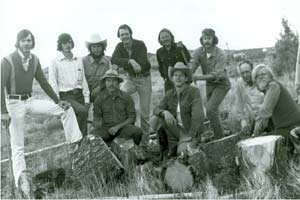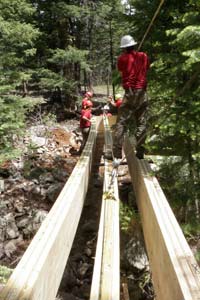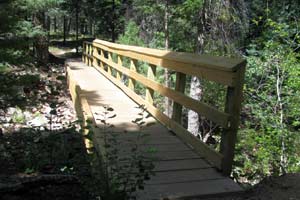During the last 200 years, Philmont has been subject to all manner of ranching, resource extraction and recreational activities. Each activity altered the landscape in its own way. Hard rock and hydraulic mining forever changed the shapes of many of our high peaks and steep-walled canyons. Intense clear cutting in the early 1900s resulted in the dense, even-aged batches of Ponderosa Pine found across the ranch. A century of wildfire suppression left the forest floor covered in a thick layer of litter and debris.
Following the gifting of the Ranch by Waite Philips, early settler and mining routes provided the only access into what was very much a wild place. Waite had developed trails that gave easy access to some of his favorite places, including the Rayado Lodge (now known as Fish Camp), the Tooth of Time and Hunting Lodge, but most other hiking routes were little more than paths through the forest worn in by the horses and boots of ranchers and trappers.
In 1965, a catastrophic flood washed down Rayado Canyon. The once beautiful trail along the Rayado River between Abreu and Fish Camp was destroyed. The route would remain closed for almost a decade as Philmont’s managers learned about trail design and construction techniques that could handle rapidly rising camper numbers.

1976 Conservation Staff Photo
Roving trail crews began operation shortly after the big flood. These crews installed trail signs and cleared obstacles and blowdowns along major trails. They laid the groundwork for the modern trail system used today.
The Conservation Department became its own entity in 1971. With only a dozen or so staff members, it took up the mantle of maintaining and expanding Philmont’s trail and camp system. One of the first trail construction projects was the Rayado Canyon trail, which still exists today. If you take a hike up this trail, you can witness amazing views that would be unattainable without those early conservation pioneers.
During the 1980’s and 1990’s, trail construction continued, and many improvements were made to camping and recreation infrastructure. Rock fire rings were gradually replaced with metal fire rings. Sumps evolved from 55-gallon barrels to the now ubiquitous drainpipe fittings. Conservation-focused treks soon developed; the 28-day Trail Crew took its place as the longest individual program on the ranch, and later the Order of the Arrow Trail Crew was born. The Department has also added three other individual programs, focusing on more than just trail construction, but comprehensive conservation education as well. the Roving Outdoor Conservation School (ROCS), Trail Crew Trek (TCT), and Science Technology Engineering Math Trek (STEM Trek) all have educational components to them but are still rooted in conservation hard skills and work projects.

The Conservation Department also added specialty positions to meet the needs of land management in the modern era. Geographic Information Systems Technicians produce Philmont’s entire sectional, overall and campsite maps. The Invasive Species Control Program, formed in 2010, is charged with managing and coordinating Philmont’s noxious weed control efforts. Philmont’s Sustainability program is also managed by the Conservation Department, and three staff members are responsible for 75 tons or recycling every summer.
The Ponil Complex Fire of 2002 spurred the largest revegetation project in the history of Philmont and taught the Department many valuable lessons about land and watershed restoration and rehabilitation following a catastrophic fire. The Ponil Complex Fire represented a jump forward in the department. It went from a summer only staff focused on trails and campsites to a legitimate year-round conservation corps dedicated to comprehensive land management. It also created the first ever alternative spring break program at a BSA High Adventure Base. Dedicated to helping in the recovery efforts, PhilBreak participants assisted in the Fire Recovery efforts until 2005.
On May 31, 2018 the Ute Park Fire began close to the Philmont Scout Ranch property line near the Cimarroncita. In response, the entirety of the 2018 summer staff became members of the Conservation Department and began work on a shaded fuel break along the Beaubien Road. Since the Ute Park Fire, The Conservation Department quadrupled the size of our forestry program and has begun working more closely with federal and state agencies to develop a compressive forest and land management plan. Philbreak also returned in 2019 to assist in the completion of fire mitigation projects.

In its current iteration, the Conservation Department has four Professional Staff; the Director of Conservation, a Forester, a Wildlife Biologist, and a Field Manager. All these positions focus on supporting the seasonal staff workers by working closely with land partners, governmental agencies, and other stakeholders to identify and plan projects to improve and restore the land we use.
Philmont Conservation Department alumni have gone on to serve the community as wilderness firefighters, professional trail builders, environmental advocates, and professional educators. The Department has produced several notable leaders in the conservation community, writing some of the literature and techniques for these fields. As the Conservation Department looks to take on another 50 years of work, we continue to take the best practices in land management to influence the outdoor experience and environmental health of Philmont.
As Philmont and Scouting look into the future, the Philmont Conservation Department will continue to adapt and develop to meet the needs of our land as well as our participants.